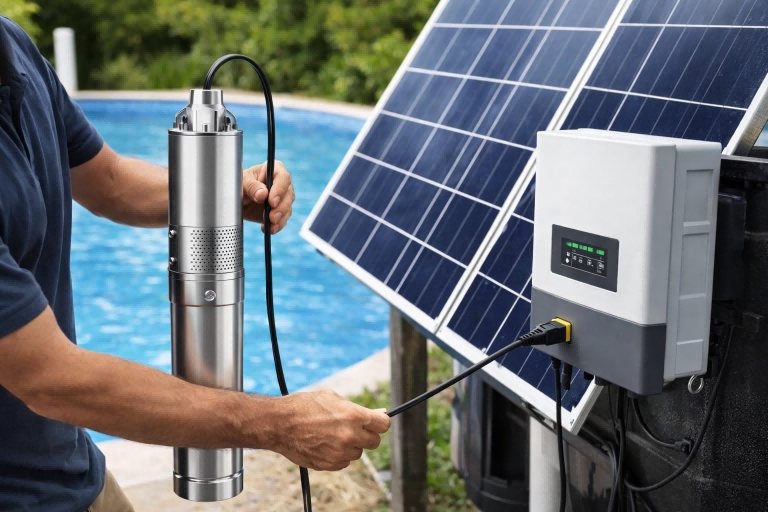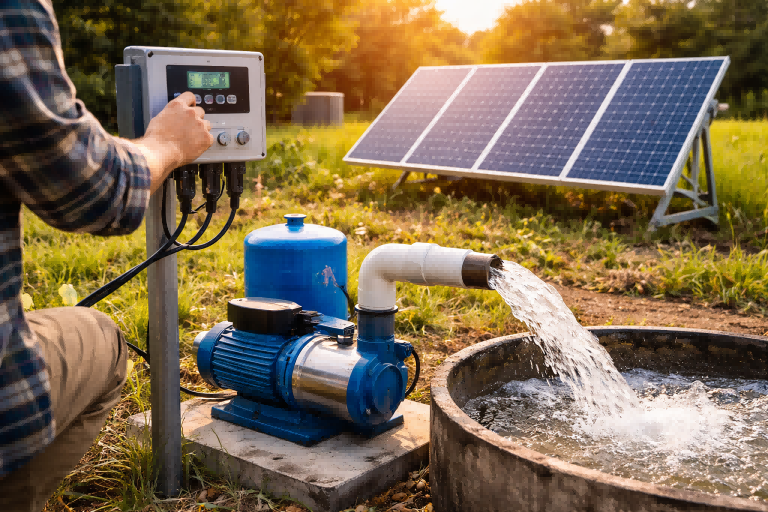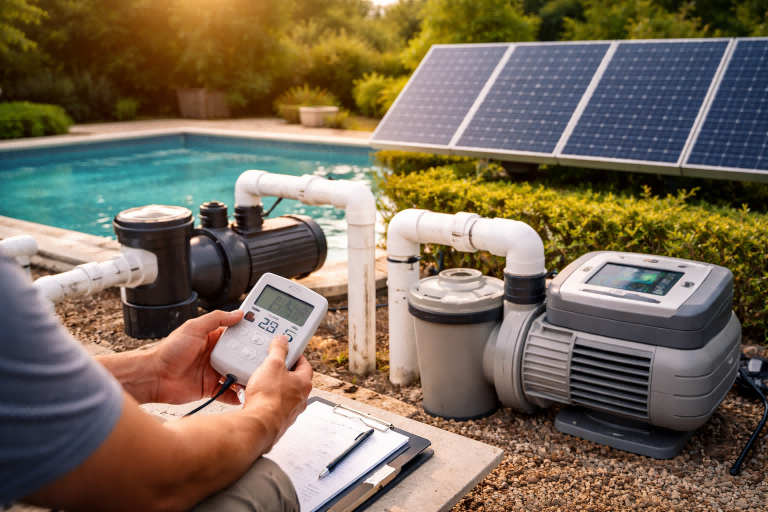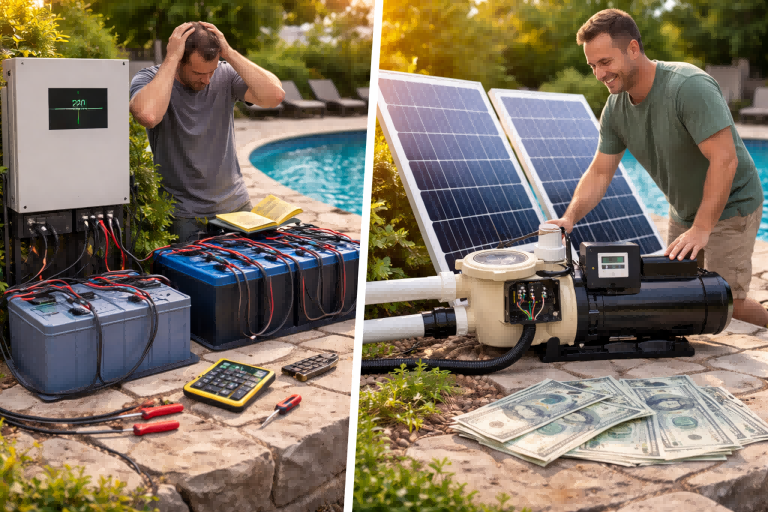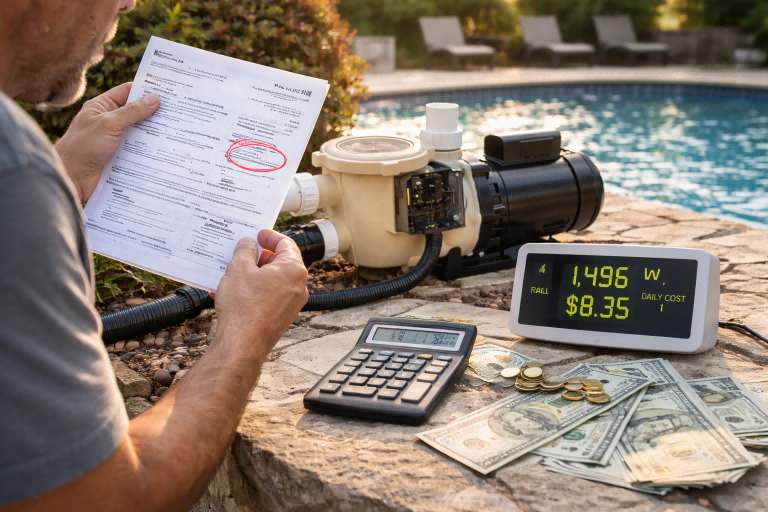Struggling to choose the right pump for your well?
The wrong choice can lead to low pressure, high energy bills, and frequent repairs, costing you time and money.
The best pump depends on your well's depth.
For shallow wells (less than 25 feet), a jet pump is a cost-effective choice.
For deep wells, a submersible pump is far more efficient and powerful, making it the superior option for most modern applications.
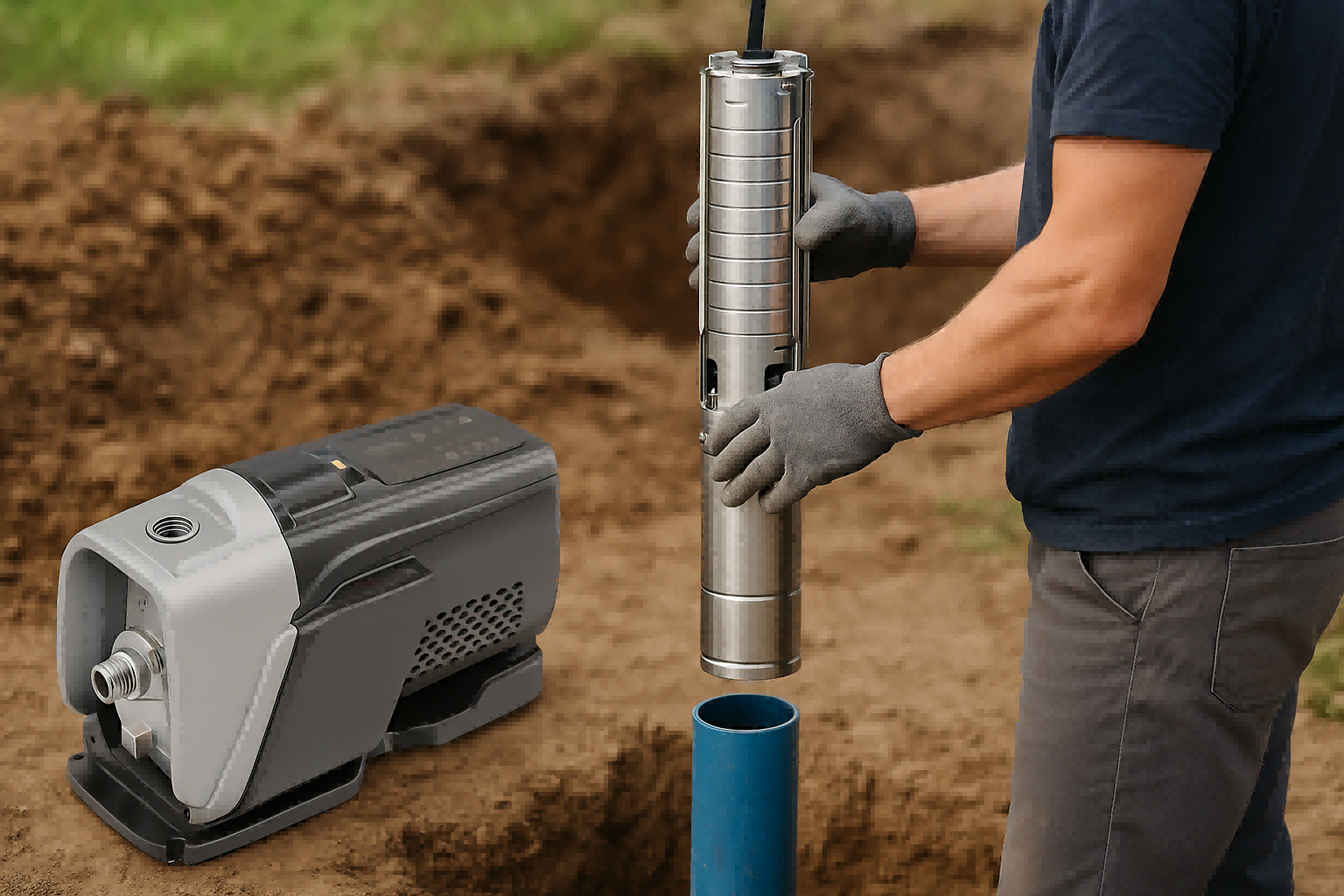
Selecting the perfect pump is a critical decision for any water system.
It impacts everything from daily water pressure to long-term operational costs.
Making an informed choice not only ensures a reliable water supply but also provides significant value to your customers and enhances your reputation as a knowledgeable supplier.
Let's dive into the details to understand which pump truly fits your specific needs.
This guide will break down the essential differences, helping you make a confident and profitable decision.
What Are Jet Pumps and Submersible Pumps?
Are you unsure about the basic mechanics of jet pumps and submersibles?
This confusion can make it difficult to explain their value to clients.
Understanding how they work is the first step to choosing correctly.
A jet pump is an above-ground unit that pulls water up from the source using suction.
A submersible pump is placed directly inside the water source, pushing water upwards.
This fundamental difference in operation dictates jejich suitability for various depths and applications.
The Mechanics of Water Movement
Understanding the core operational principles of these two pump types is crucial for making the right selection.
They both move water, but they achieve this goal in fundamentally different ways.
This difference impacts their efficiency, power, and ideal use cases.
How a Jet Pump Works: The Power of Suction
A jet pump operates from a location above the water source.
It is not submerged in the well.
It uses a centrifugal pump and a venturi-like jet nozzle to create a vacuum.
This suction force literally pulls water up from the well through an intake pipe.
- Shallow Well Jet Pumps: These models use a single pipe to draw water from depths of up to 25 feet (about 7.6 meters).
- Deep Well Jet Pumps: For wells deeper than 25 feet, a two-pipe system is required. One pipe forces water down to the jet assembly, which then helps lift water up the second pipe.
Even with this two-pipe setup, jet pumps become increasingly inefficient as depth increases.
They are generally not recommended for wells deeper than 150 feet (about 45 meters).
How a Submersible Pump Works: The Efficiency of Pushing
A submersible pump, as its name implies, is fully submerged within the water source.
It is a long, cylindrical unit that contains a sealed motor and a series of impellers.
Instead of pulling water, it pushes it.
The motor drives the impellers, which spin and push water up the pipe to the surface.
This method is highly efficient for several reasons.
First, pushing water is more energy-efficient than pulling it, especially over long distances.
Second, the surrounding water helps to cool the pump's motor, preventing overheating and extending its life.
Finally, because the pump is at the bottom of the well, it does not have to fight against atmospheric pressure to lift the water, allowing it to work effectively at much greater depths.
A Comparative Overview
To better illustrate the differences, let's look at a simple table.
| Feature | Jet Pump | Submersible Pump |
|---|---|---|
| Location | Above ground | Inside the well, underwater |
| Operation | Pulls water using suction | Pushes water to the surface |
| Priming | Requires initial priming | Self-priming |
| Cooling | Air-cooled | Water-cooled |
| Efficiency | Lower, especially in deep wells | Higher, more energy-efficient |
This foundational knowledge is key.
It allows you to assess a project's needs and confidently recommend a pump that will perform reliably and efficiently for years to come.
Choosing based on these principles prevents common installation errors and customer dissatisfaction.
Key Differences in Installation and Location
Worried about a complex and costly pump installation?
Choosing a pump that's difficult to install for your specific well type leads to higher labor costs and potential system failures.
Understanding the installation nuances is key.
Jet pumps are installed above ground, making them easier to access for maintenance but limited to shallow wells.
Submersible pumps are installed inside the well, which is more complex but necessary for deep wells and offers a cleaner, quieter setup.
Choosing a pump isn't just about performance; it's about practicality.
The installation process and physical location of the pump are major factors that influence cost, maintenance, and long-term viability.
Let's explore where these pumps are placed and what the installation process entails for each.
Jet Pump Installation: Above-Ground Accessibility
The most defining feature of a jet pump installation is its location.
It is always situated above ground, typically in a pump house, basement, or utility shed.
This has several important implications.
Advantages of Above-Ground Installation:
- Easy Access: Because the pump is not in the well, it is easily accessible for inspection, maintenance, and repair. This can significantly reduce the labor costs associated with service calls.
- No Heavy Lifting from Well: The pump itself does not need to be pulled from a deep well for service, which simplifies the repair process.
Disadvantages and Location Constraints:
- Protection from Elements: The pump must be sheltered from rain, snow, and freezing temperatures. A dedicated, insulated pump house is often necessary, adding to the overall installation cost.
- Proximity to the Well: The pump needs to be located as close to the wellhead as possible to maximize its suction capability. Long horizontal pipe runs can reduce efficiency.
- Depth Limitation: This is the most critical constraint. Due to the physics of atmospheric pressure and suction, single-pipe jet pumps are only effective for water levels up to 25 feet deep. Two-pipe models can go deeper, but their efficiency drops sharply.
Submersible Pump Installation: Down-the-Hole Complexity
A submersible pump is installed directly inside the well casing, deep below the ground and fully underwater.
This out-of-sight installation offers a very different set of challenges and benefits.
The Installation Process:
The pump is attached to a long section of rigid or flexible pipe.
An electrical cable, specifically designed for underwater use, is attached alongside the pipe.
The entire assembly—pump, pipe, and cable—is carefully lowered into the well until the pump is situated well below the lowest expected water level.
This process often requires specialized equipment, like a pump hoist or even a small crane, especially for very deep wells.
Benefits of In-Well Installation:
- No Above-Ground Footprint: There's no need for a pump house, saving space and reducing visual clutter on the property.
- Self-Priming: Since the pump is already underwater, it is always primed and ready to go.
- Protection: The pump is naturally protected from weather and freezing by being deep underground.
Installation Challenges:
- Complex Service: If the pump fails or needs maintenance, the entire assembly must be pulled up from the well. This is a labor-intensive and costly process.
- Well Diameter: The pump must fit inside the well casing. This is usually not an issue for standard 4-inch or 6-inch wells, but it's a critical measurement to check.
Installation Factor Showdown
Here is a breakdown of installation factors to consider.
| Installation Factor | Jet Pump | Submersible Pump |
|---|---|---|
| Typical Location | Pump house, basement (above ground) | Inside the well (below ground) |
| Accessibility for Repair | High and easy | Low (requires pulling from well) |
| Protection Needed | Requires shelter from weather/frost | Naturally protected underground |
| Installation Complexity | Simpler plumbing, but needs housing | Complex (requires lifting equipment) |
| Priming Required | Yes, must be primed manually | No, self-priming |
| Space Requirement | Needs dedicated, dry, protected space | Only requires access to the wellhead |
Understanding these installation differences is vital for quoting a project accurately.
A jet pump might seem cheaper upfront, but the cost of building a pump house can sometimes offset the savings.
Conversely, the higher initial cost of a submersible pump and its installation can be justified by its superior performance and lack of an above-ground footprint, especially for deep well applications.
Performance and Efficiency: A Head-to-Head Comparison
Concerned about high energy bills and poor water pressure?
An inefficient pump wastes electricity and fails to deliver the consistent flow your customers expect, leading to complaints and tarnishing your reputation.
Choosing the most efficient pump is a sound business decision.
Submersible pumps are significantly more energy-efficient than jet pumps.
By pushing water instead of pulling it, they use less energy to deliver higher flow rates and stronger, more consistent pressure, especially in deep-well applications.
The Critical Role of Energy Consumption
In today's market, performance is not just about moving water.
It's about moving it efficiently.
Energy consumption is a massive part of the total cost of ownership for any pump.
As a distributor, offering energy-efficient solutions like VFD-driven pumps gives you a competitive edge.
It's what knowledgeable clients like Andrew in Australia are looking for.
Why Submersible Pumps Excel in Efficiency
The primary advantage of a submersible pump is its fundamental design.
Pushing water from the bottom of a well is far more efficient than pulling it from the top.
Here's a breakdown of why.
1. The Physics of Pushing vs. Pulling:
A jet pump fights against gravity and atmospheric pressure to create a vacuum and suck water up.
This process is inherently inefficient and has a hard physical limit.
A submersible pump, on the other hand, is submerged in the water.
It uses its energy directly to push a column of water upwards.
This direct-drive action minimizes energy loss.
2. Motor Cooling:
Submersible pump motors are hermetically sealed and cooled by the surrounding well water.
A cooler motor runs more efficiently and has a longer lifespan.
A jet pump's motor is air-cooled, making it more susceptible to overheating, especially in hot climates or enclosed spaces.
3. Priming and Energy Waste:
Jet pumps can lose their prime, meaning they run without pumping water.
This not only wastes energy but can also damage the pump motor if it runs dry for too long.
Submersible pumps are always submerged, so they are self-priming and never run dry as long as the water level is sufficient.
The Rise of Variable Frequency Drive (VFD) Technology
For ultimate efficiency, modern submersible pumps can be paired with a Variable Frequency Drive (VFD), also known as a variable speed drive (VSD).
This is a game-changer for water systems.
A VFD adjusts the pump motor's speed in real-time to match water demand.
Instead of the pump running at full power every time a tap is opened, the VFD supplies just enough power to maintain a constant, pre-set pressure.
This technology, central to RAFSUN's product line, offers huge benefits.
Benefits of VFD-Equipped Submersible Pumps:
- Massive Energy Savings: By adjusting motor speed, a VFD can reduce electricity consumption by up to 50% or more compared to a traditional fixed-speed pump.
- Constant Water Pressure: It eliminates the pressure fluctuations common with standard pump systems. No more weak showers when someone flushes a toilet.
- Soft Start/Stop: VFDs gradually ramp up and slow down the motor, reducing mechanical stress (water hammer) on pipes and extending the life of the entire system.
Performance Metrics: Pressure and Flow Rate
Efficiency directly impacts a pump's ability to deliver consistent pressure and flow.
| Performance Metric | Jet Pump | Submersible Pump |
|---|---|---|
| Maximum Pressure | Moderate. Decreases significantly with depth. | High. Can deliver strong pressure from great depths. |
| Flow Rate (GPM) | Good for shallow wells. Poor for deep wells. | Excellent. Maintains high flow rates even from hundreds of feet deep. |
| Consistency | Can fluctuate as the pressure tank cycles. | Very consistent, especially when paired with a VFD. |
| Energy Efficiency | Low to moderate. | High to very high. |
For any application deeper than a shallow well, a submersible pump outperforms a jet pump on every key metric.
When you add a VFD to the system, the submersible pump becomes an intelligent, energy-saving solution that provides a superior user experience.
This is the kind of high-value, high-tech package that modern distributors can market successfully.
Maintenance, Longevity, and Cost of Ownership
Thinking about the long-term costs of your pump?
A pump that requires frequent, complicated repairs can quickly erase any upfront savings, leading to customer dissatisfaction and reduced profitability.
A reliable pump is a better investment.
While jet pumps are easier to access for repairs, submersible pumps are more reliable and have a longer lifespan.
The lower energy bills and fewer service needs of a submersible pump often result in a lower total cost of ownership over time.
Looking Beyond the Initial Purchase Price
A smart buyer, like your typical customer "Andrew," looks at the big picture.
The sticker price of a pump is just one part of the equation.
The true cost of a pump is its Total Cost of Ownership (TCO), which includes the initial purchase, installation, energy consumption, and maintenance costs over its entire lifespan.
A pump that is cheaper to buy but more expensive to run and maintain is not a good deal.
Maintenance Realities: Accessibility vs. Reliability
The maintenance profiles of jet and submersible pumps are polar opposites.
Jet Pump Maintenance:
A jet pump's greatest advantage in this category is its accessibility.
Located above ground, all its components are within easy reach.
Troubleshooting issues like a loss of prime, a leaking seal, or a faulty pressure switch can be done without specialized equipment.
- Common Issues:
- Loss of Prime: This is the most frequent problem, often caused by a small leak in the suction pipe.
- Seal Failure: The seals around the motor shaft can wear out, causing water leaks.
- Nozzle Clogging: The jet nozzle assembly can become clogged with sediment, reducing performance.
- Lifespan: A well-maintained jet pump typically lasts 5 to 10 years. Their constant exposure to the elements and air-cooled nature can lead to faster wear and tear.
Submersible Pump Maintenance
A submersible pump is built for reliability.
Sealed from the elements and cooled by water, these pumps are designed to operate for years without any intervention.
However, when they do fail, the maintenance process is significantly more involved.
- Common Issues:
- Motor Failure: Though rare, the sealed motor can burn out, often due to running against a closed valve (dead-heading) or electrical issues like a power surge.
- Impeller Wear: In sandy or gritty wells, the impellers can wear down over time, reducing the pump's effectiveness.
- Check Valve Failure: The built-in check valve can fail, allowing water to drain back into the well and causing the pump to cycle more frequently.
- The Big Challenge: Repairing a submersible pump requires pulling the entire unit, along with hundreds of feet of pipe and cable, out of the well. This is a job for professionals with the right equipment and is considerably more expensive than a typical jet pump repair.
- Lifespan: Despite the difficult repairs, a quality submersible pump has a much longer average lifespan, often lasting 10 to 15 years, with some units functioning for 20 years or more.
Calculating the Total Cost of Ownership (TCO)
To truly compare these pumps, you must consider all costs over a 15-year period.
| Cost Factor | Jet Pump | Submersible Pump |
|---|---|---|
| Initial Purchase Price | Lower | Higher |
| Installation Cost | Moderate (may require pump house) | Higher (requires pulling equipment) |
| Energy Consumption | High | Low (especially with VFD) |
| Maintenance Frequency | More frequent, but cheaper per repair | Less frequent, but more expensive per repair |
| Average Lifespan | 5-10 years (may need 2 pumps in 15 years) | 10-15 years (likely 1 pump in 15 years) |
| Estimated 15-Year TCO | Higher | Lower |
Even though a jet pump has a lower initial cost, its higher energy use and shorter lifespan mean you'll likely buy two pumps and pay significantly more in electricity over 15 years.
The submersible pump, despite its higher upfront cost, proves to be the more economical choice in the long run.
This is a powerful selling point for quality-focused buyers who are interested in long-term value, not just short-term savings.
Noise, Priming, and Operational Considerations
Tired of a noisy pump that constantly needs attention?
A loud, high-maintenance pump is a major annoyance, leading to customer complaints and the perception of a low-quality system.
Smooth, quiet operation is a hallmark of a superior product.
Submersible pumps are virtually silent because they operate deep underground, and they are self-priming.
Jet pumps are noisy because their motor is above ground, and they require manual priming, which can be a recurring hassle if there are any leaks.
The Everyday User Experience
Beyond performance charts and cost calculations, the daily operational characteristics of a pump have a huge impact on customer satisfaction.
These are the "quality of life" features that differentiate an adequate system from a great one.
Factors like noise and the need for regular user intervention are critically important.
The Sound of a Pump: Noise Levels Compared
The difference in noise levels between a jet pump and a submersible pump is dramatic.
Jet Pump Noise:
A jet pump is essentially an electric motor and pump head sitting in a basement or a shed.
When it runs, you hear it.
The noise is a combination of the electric motor's hum and the sound of the pump moving water.
This can be a significant disturbance, especially if the pump is located near living quarters.
The constant cycling on and off of a traditional pressure tank system can be particularly annoying.
- Noise Level: Comparable to a washing machine or dishwasher, typically 60 to 80 decibels.
- Location Impact: If installed in a basement, the noise can travel through the house. In an outdoor pump house, it can be a source of noise pollution in the yard.
Submersible Pump Silence:
A submersible pump is the clear winner for quiet operation.
Its location deep inside the well, underwater, makes it virtually silent from the surface.
The earth and water act as natural, perfect sound insulators.
The only sound you might hear is a faint click from the pressure switch in the control box, which is usually located away from living areas.
- Noise Level: Nearly 0 decibels at the surface.
- User Benefit: The silent operation is a major selling point for residential applications. It provides a peaceful, unobtrusive water supply.
The Hassle of Priming
Priming is the process of filling the pump and suction pipe with water to create the necessary vacuum for operation.
Why Jet Pumps Need Priming:
Since a jet pump works by suction, its intake line must be completely full of water and free of air.
If air gets into the line—often due to a tiny, almost undetectable leak in a fitting or pipe—the pump will lose its "prime" and stop pumping water, even though the motor is running.
Re-priming involves manually pouring water into the pump housing until it and the suction line are full again.
This can be a frequent and frustrating task for the homeowner.
Why Submersible Pumps Don't:
A submersible pump is self-priming by design.
It sits underwater, so its intake is always flooded.
It is always ready to pump water the moment it receives power.
This eliminates one of the most common points of failure and frustration associated with well pumps.
Key Operational Factors
Let's summarize the daily operational differences.
| Operational Factor | Jet Pump | Submersible Pump |
|---|---|---|
| Noise Level | Loud (60-80 dB) | Virtually Silent (0 dB) |
| Priming | Requires manual priming; can lose prime | Self-priming; never needs priming |
| Exposure to Elements | Vulnerable to freezing and weather | Protected deep underground |
| User Intervention | May require frequent re-priming | Virtually zero user intervention needed |
For a distributor, highlighting these operational benefits is key.
A submersible pump offers a "set it and forget it" experience.
This level of convenience, combined with silent operation, is a powerful argument for its superiority.
When you offer a system that is not only powerful and efficient but also unobtrusive and hassle-free, you are providing a premium solution that justifies its price.
Choosing the Right Pump for Specific Applications
How do you guarantee you're recommending the perfect pump for every job?
Giving the wrong advice can lead to an underperforming system, a costly replacement, and a damaged professional relationship.
Matching the pump to the application is the mark of a true expert.
Use a shallow well jet pump for water sources less than 25 feet deep.
For any well deeper than 25 feet, or for applications demanding high pressure and efficiency like home water supply or irrigation, a submersible pump is the superior choice.
Matching the Technology to the Task
The debate between jet pumps and submersible pumps is not about which one is universally "best," but which one is best for a specific job.
An expert supplier understands the nuances of different applications and can guide their clients to the optimal choice.
This builds trust and ensures the end-user receives a system that meets or exceeds their expectations.
When to Choose a Jet Pump
Despite the many advantages of submersible pumps, jet pumps still have a place in the market.
Their strength lies in specific, cost-sensitive, shallow-water applications.
Ideal Applications for a Jet Pump:
- Shallow Wells: For a well, cistern, or reservoir where the water level is consistently less than 25 feet (7.6 meters) from the ground, a simple shallow well jet pump is a very cost-effective solution.
- Lifting from Lakes or Ponds: They are a good choice for pulling water from a lake or pond for small-scale irrigation, provided the pump can be placed close to the water's edge and the lift height is minimal.
- Temporary or Portable Setups: Because they are not permanently installed in a well, jet pumps can be used for temporary dewatering tasks or as a portable water transfer solution.
It is crucial to remember that as you approach the 25-foot suction limit, the performance of a jet pump drops dramatically.
A two-pipe deep well jet pump can be used for greater depths, but it is much less efficient than a submersible pump and is rarely the best choice in modern installations.
When a Submersible Pump is the Only Real Choice
For the vast majority of modern well applications, a submersible pump is the standard for good reason.
Its design makes it unbeatable in performance, efficiency, and reliability for deep water sources.
Prime Applications for a Submersible Pump:
- Deep Wells: This is their primary application. Any drilled well deeper than 25 feet should use a submersible pump. They operate efficiently at depths of hundreds of feet, where a jet pump cannot function at all.
- Home Water Supply: For providing water to a household, a submersible pump paired with a VFD and pressure tank delivers quiet, consistent, high-pressure water that modern families expect.
- Irrigation Systems: Large lawns, gardens, or small agricultural plots require consistent high flow and pressure, which a submersible pump can easily provide.
- Geothermal Systems: These systems often rely on submersible pumps to circulate water through deep underground loops.
Application Decision Matrix
Here is a simple decision matrix to help guide your recommendation.
| Application | Recommended Pump | Key Reason |
|---|---|---|
| Residential Well (< 25 ft) | Jet Pump | Lower initial cost for shallow depth. |
| Residential Well (> 25 ft) | Submersible Pump (with VFD) | Efficiency, pressure, reliability, and quiet operation. |
| Small Garden Irrigation (from a pond) | Jet Pump | Cost-effective for low-lift, horizontal transfer. |
| Large Area Irrigation (from a well) | Submersible Pump | High flow and pressure needed from depth. |
| Cabin/Vacation Home (shallow well) | Jet Pump | Lower upfront cost for intermittent use. |
| Commercial Building Supply | Submersible Pump | High demand and reliability requirements. |
| Boosting Municipal Water Pressure | In-line Booster Pump (e.g., RAFSUN VSD Booster) | This is a specialized application. Neither a jet nor submersible is ideal. |
By mastering this application knowledge, you transform from a simple equipment seller into a valuable solutions provider.
You can confidently advise clients like Andrew, helping them select a pump that not only works but excels.
This expertise, especially in promoting advanced solutions like VFD-driven submersible systems for deep wells, solidifies your position as a market leader and a trusted partner.
Conclusion
In summary, submersible pumps offer superior efficiency, silent operation, and long-term reliability for deep wells.
Jet pumps are a simpler, cost-effective choice but only for very shallow water sources.
FAQs
1. Can a jet pump be used for a 100 foot well?
A deep well jet pump can technically work at 100 feet.
However, it will be very inefficient.
A submersible pump is the far better choice for this depth.
2. Is a submersible pump better than a jet pump?
For most wells deeper than 25 feet, yes.
A submersible pump is more efficient, quieter, and provides better pressure than a jet pump.
3. How long does a submersible well pump last?
A quality submersible pump typically lasts 10 to 15 years.
Its lifespan depends on water quality, usage, and proper installation.
4. What are the disadvantages of a submersible pump?
The main disadvantages are the higher initial cost and difficult repairs.
If it fails, it must be pulled out of the well for service.
5. Do you need a pressure tank with a submersible pump?
Yes, a pressure tank is typically used.
It reduces pump cycling and works with a VFD to provide constant, stable water pressure.
6. Can a submersible pump run continuously?
A properly sized submersible pump can run for long periods, especially for irrigation.
Continuous running is fine as long as it's within its design parameters.
7. How do I know if my jet pump or submersible pump is bad?
Signs include no water, low pressure, the pump cycling on and off rapidly, or high electric bills.
A professional diagnosis is often needed to confirm the issue.
8. Is it expensive to replace a submersible pump?
The replacement itself can be expensive.
The cost includes the new pump plus the significant labor to pull the old pump and install the new one.


